Bakery racks are an integral part of kitchen equipment, which helps to do the job efficiently and swiftly. Read our complete guide to one of the most common bakery essentials created by Schaumburg Specialties, a leading provider of commercial kitchen racks for almost 30 years, that has had lots of hands-on experience in their construction and design.
Types of Bakery Racks
Baking is an art. And as with any art form, a creator needs a lot of tools. However, with such a wide variety of bakery racks, it can get a little tricky. Therefore, we have described all types of commercial bakers racks for you to be successful in the business.
Conventional Racks
Conventional bakery rack is a rectangular prism consisting of sides and cross members. The conventional rack or prism is a structure designed to support the baking sheet pan and its contents, and not just one, but most often multiple pans. And as well as the pans this structure needs to allow the attachment of wheels or any other option to serve its purpose.
One of the conventional racks benefits is that they are opposed to the nesting type design in our case, SPACECraft. Typically conventional racks are stronger than nesting racks because of the tie points. On a typical SHOPCraft conventional rack, there are twelve connection points that help hold the rack rigid and support its load both when the rack is stationary and when in movement whereas on a nesting rack the connection points are reduced to six.
Cooling Racks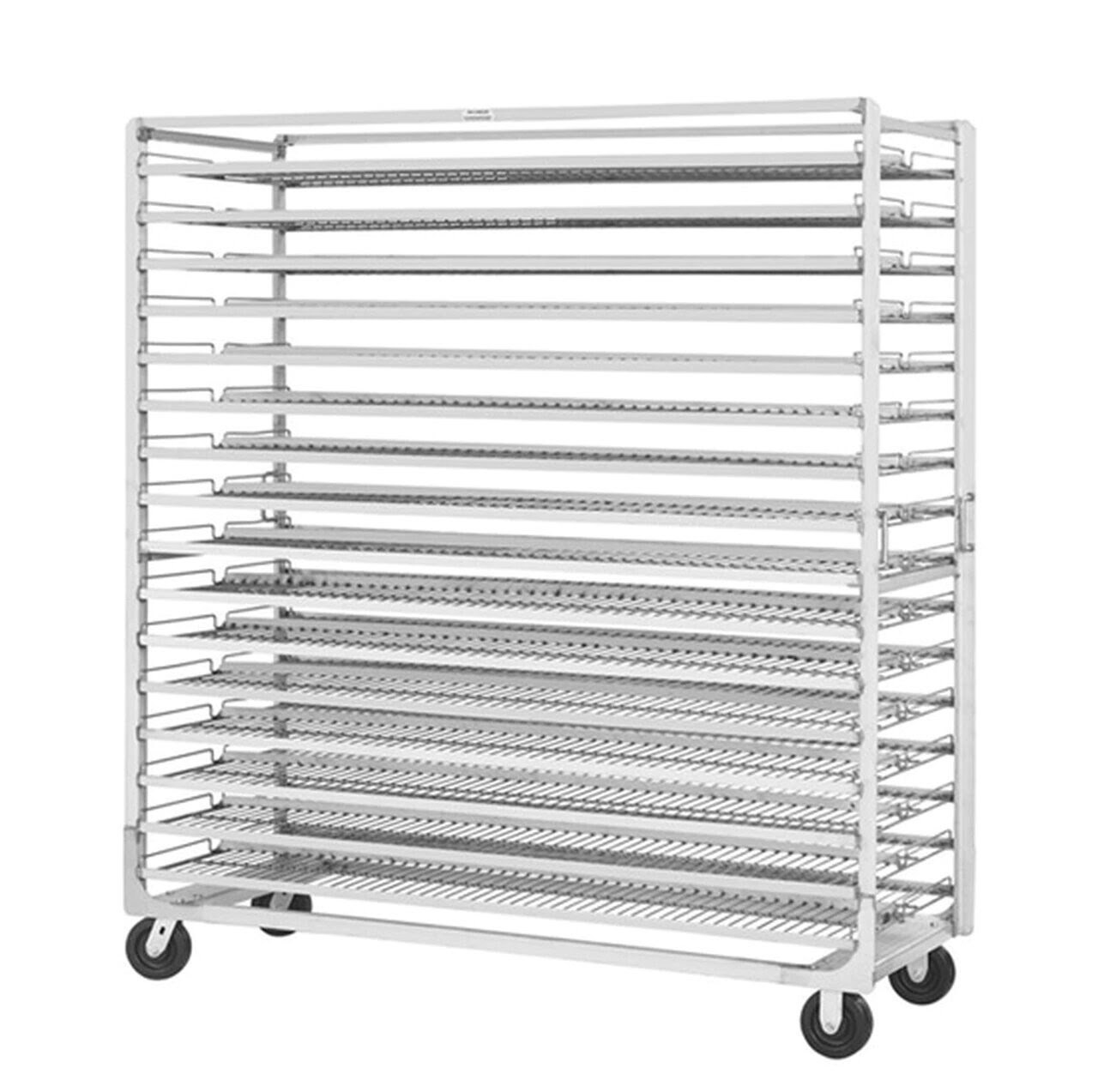
A cooling rack is an object, usually a dedicated cart or stationary unit with wire shelves to allow heat to dissipate from a product. Cooling racks can be used in a variety of applications from a depanning operation to the storage of product prior to packaging. But typically they are used to remove heat and moisture from a baked product after the baking cycle. To learn more about cooling racks, read our blogpost.
Nesting Racks
A nesting rack is a rectangular prism just like a conventional rack but the cross members are placed diagonally to allow the shape of one rack to nest into the shape of another.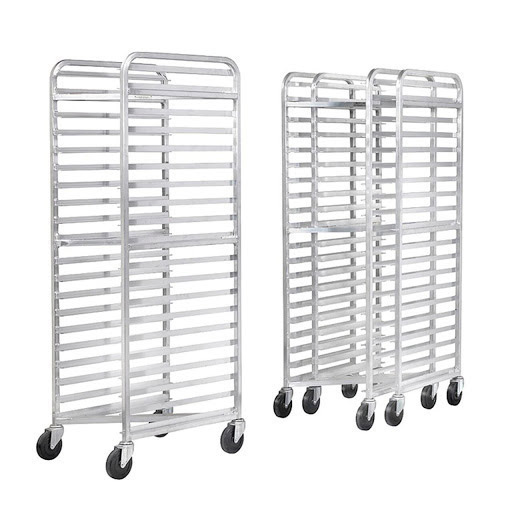
The whole purpose of nesting racks SPACECraft is to save space. However, keep in mind that only when the nesting rack is free of pans will the nesting feature be available, because when the nesting rack is loaded the racks will not nest.
Often nesting racks do not have the integrity or the same capacity of a conventional rack resulting in a sway when the rack is loaded. It means that when the rack moves by pushing on the side or end, the top of the rack begins to move before the bottom of the rack where the wheels are supporting the entire load. This sway is the flexing or bending of the structure and its joints that may be described well as a dancer. But unlike the joints of a dancer, the rack is not intended to flex in this manner resulting in the premature failure of the materials and joining methods.
The percentage of the nest is another consideration of this design and nesting is never 100 percent. So for instance the typical nesting SPACECraft ARSN model nests at about 40%. This means that two racks save about 40% of the same two racks not nested.
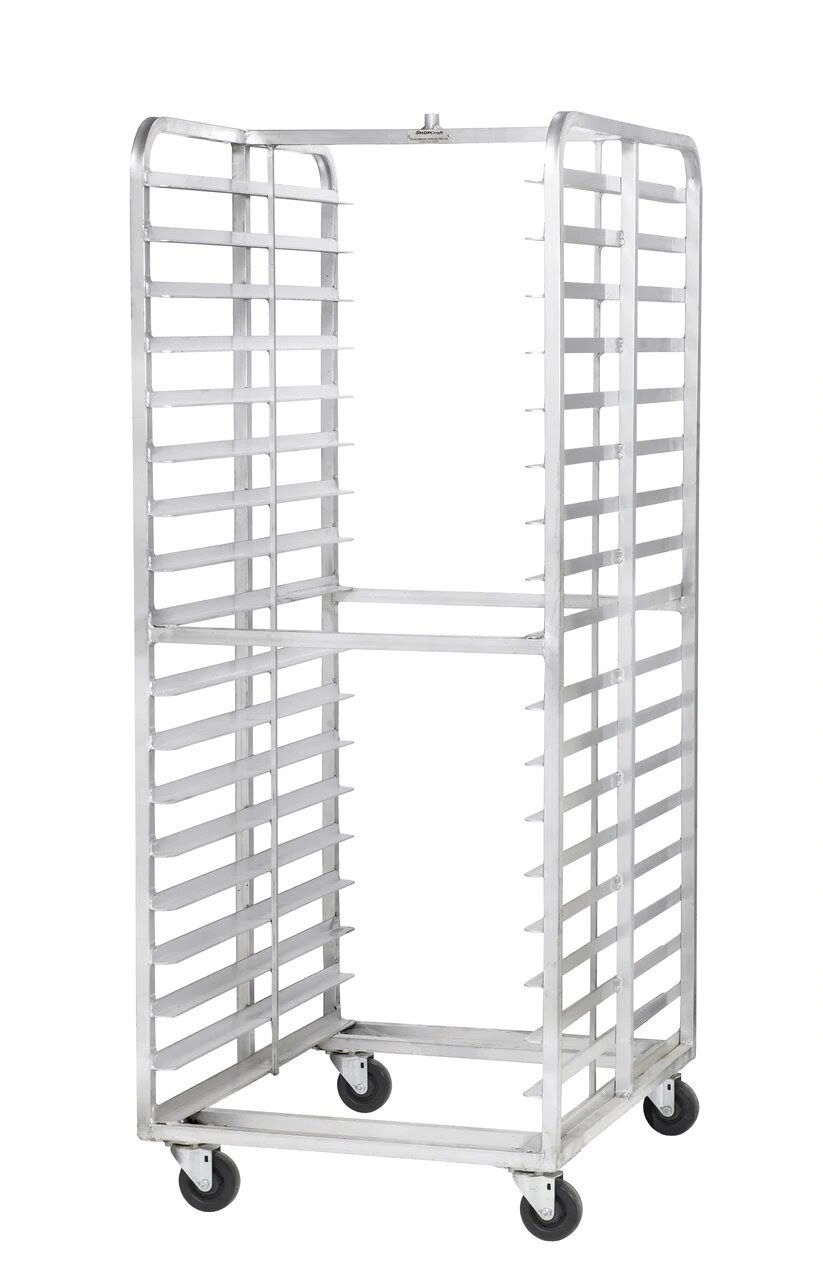 Oven Racks
Oven Racks
An oven rack can be either conventional SHOPCraft or nesting SPACECraft. What differentiates an oven rack is that the wheels in the caster brackets are intended to withstand the high temperatures of a baking oven.
Another difference of an oven rack is that often the typical convection rack oven has a lift mechanism inside the baking chamber that couples the rack to the lift. The purpose of this lift mechanism is to raise the rack off the wheels while in the baking chamber. This also allows the rack to revolve by the lift facilitating a more consistent product. But remember that not all nesting SPACECraft racks are compatible with all the different oven lifts.
KD (Knock Down) Flat Pack or Bolt Together
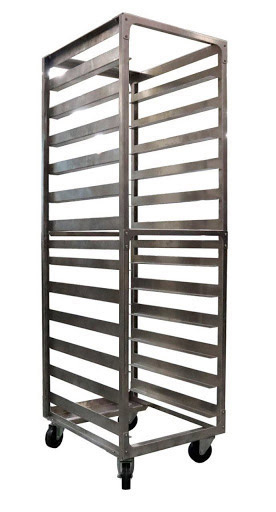 These racks are also rectangular prisms with the exception that the design allows for the collapsing or flat packing of the major components.
These racks are also rectangular prisms with the exception that the design allows for the collapsing or flat packing of the major components.
There are two benefits of this design. The first allows the customer or user to assemble the rack saving the manufacturing cost of a factory assembled unit. And the second one allows the shipment or transport of a more densely packaged product to save on shipping costs.
These two reasons and not always benefits, however. Bolt-together designs also have a weakness. At each assembly point, you have a mechanical fastener typically a bolt or a screw. These fastening points can become loose over time requiring maintenance (retightening). If the fastening points are allowed to remain to lose the rack will become unstable (sway) and will prematurely deteriorate at these points by the holes becoming enlarged and the base metal becomes fatigued and crack.
Welded vs Knock Down Construction
Most bakery rack design would incorporate one or both of these construction methods. The advantage of a fully welded conventional or nesting rack allows the customer to begin using the rack straight away typically without any additional assembly. Racks may be shipped without casters attached but this would be a decision made between the buyer and manufacture. Welded racks also typically have the best longevity with no fasteners to become loose or fail.
Knock down or flat pack racks, as already pointed out, are easier and more cost-effective to ship and are less expensive than a welded rack as the customer or user supplies labor to assemble.
Rack Material Features
Most of the bakery racks are typically constructed out of stainless steel of aluminum because of the need for corrosion resistance and sanitation. Let’s consider these rack materials in a more detailed way.
Stainless Steel
Stainless steel is typically an expensive product but the material is superior in corrosion resistance and strength. Overall stainless steel is the superior metal of choice in a food production application. Even though the initial cost may be more than that of other metals the long term value outweighs the cost.
Aluminum
Aluminum is a good choice because of the high strength to weight ratio of the material and its relatively good corrosion resistance. Aluminum has a better heat dissipation rate than stainless steel so may produce better results in a cooling or freezing application than stainless steel. But
Aluminum rack does scratch easily and sometimes with the interaction with other metal parts such as an oven lift heavy use scratching can result and sometimes will result in small flakes coming off the rack that can contaminate the product. This being said we still have many customers that have satisfactory results and are happy with the performance of aluminum constructed bakery racks.
Shape
Another aspect of the construction of a bakery rack is the use of different shapes of the materials used, for example, hollow shapes or tubing are used in the structural design many times. But sometimes sanitation requirements require that no hollow shapes (tubing) be used. It is generally accepted that any hollow shape no matter how tightly sealed will eventually develop a crack or opening allowing wash water to enter creating an unsanitary situation. Fasteners used in either welded or bolt-together construction are generally zinc plated steel or stainless steel. Zinc-plated steel will corrode or rust over time while stainless steel will last indefinitely.
Basic Rack Configuration
Pan racks are configured in several basic ways. Let’s look at some of them.
Single/Double
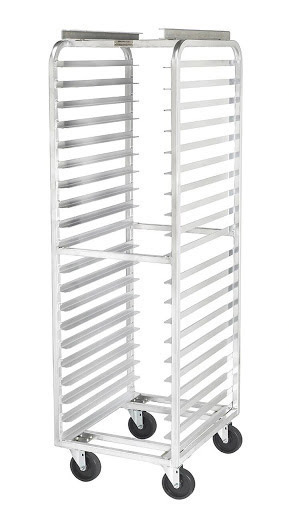
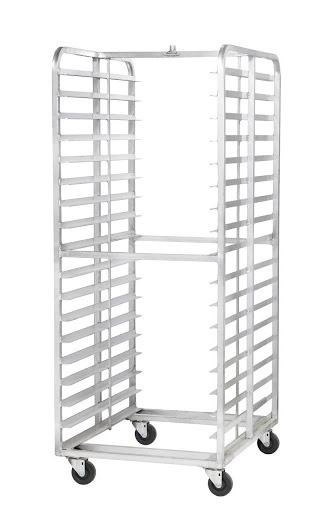
What is meant by this is how the pan is supported, and how many pans on each level is. At Schaumburg Specialties if a rack supports one pan per level this is called a
single rack. If a rack supports two pans per level this is called a double rack. So if you have a 15 level double rack you are containing 30 pan or have a 30 pan capacity rack. Sometimes in smaller bakeries, the use of double racks is prohibitive because double racks have the footprint of two single racks so that is why this requires more space to maneuver than the single style racks.
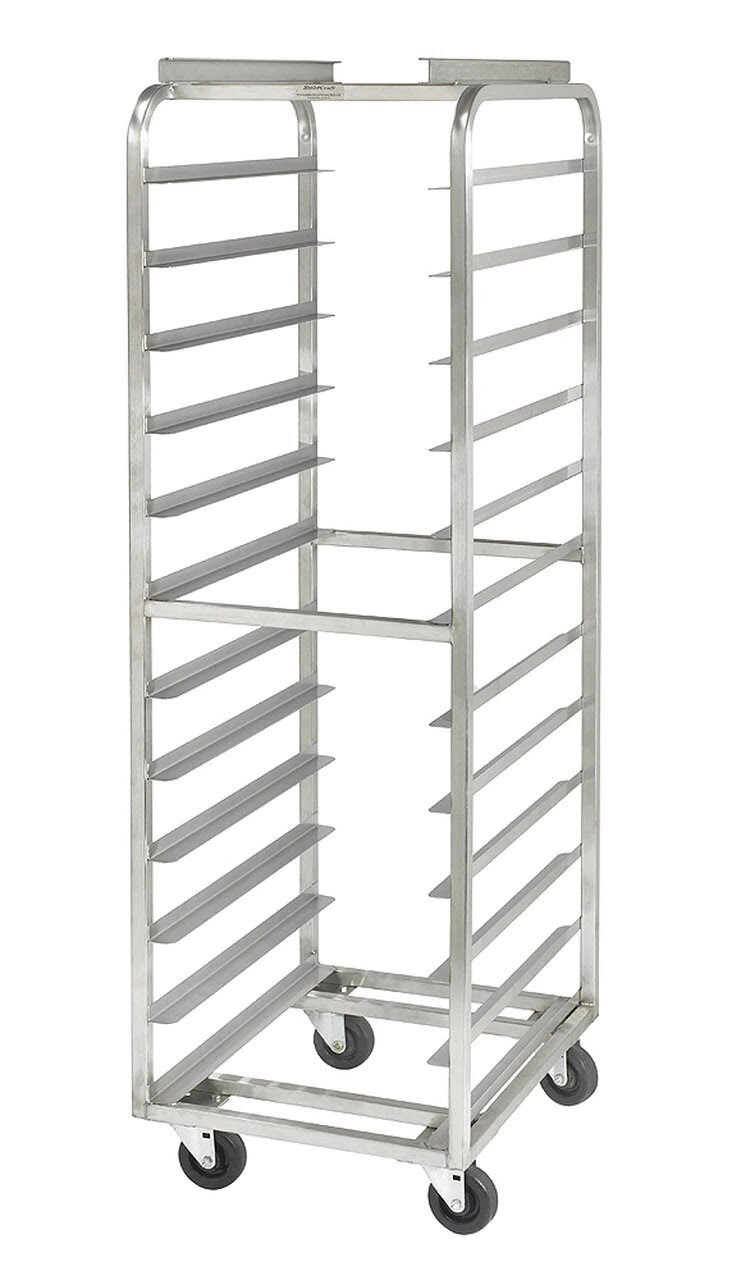 Side Load / End Load
Side Load / End Load
Side load and End load configuration is the way the pan is supported by the rack. Usually, on a double rack, a rack that supports two pans per level, these support the pan from the short side of the baking pan. However, on a single rack side load and end load can make a big difference. On a side load single rack the wide side of the pan is inserted into the racks and is supported by the short side. At times this configuration is preferred because of having to navigate a narrow ramp. This means that when the rack is pushed uphill or downhill the pans are contained by the side panel of the rack.
Support of the Pan
The pan of a bakery rack is usually supported by the bottom of the pan. This support angle or slide is just large enough to catch the bottom of the pan.
Sometimes when multiple pans are used on a rack or a strap pan is used the slide needs to be wider than standard. The size of your slide needs to be large enough to support the smallest pan when the smallest pan is positioned to one side of the rack.
Typical bakery racks are designed to accommodate usually only one size pan. However, sometimes design can be changed to work with several pans depending on the size. Often the desire is for the rack to accommodate all the pans used. This can be done but often requires a grid either permanently attached to the rack or a separate grid that fits on the standard slides. In these cases, the cost is usually a deciding factor as racks with a wire grid shelf can be more expensive.
Sometimes if the rack is to accommodate a large number of pans, the pans can be supported from the lip. In this configuration, pans can be spaced closer together than when supported by the bottom because on the use of a channel or angle that holds two pans per support instead of just one.
Another reason for supporting from the lip or rim of the pan is because the container such as a plastic lug or tote has a tapered shape and the bottom of the container is such that if supported from the bottom would be impractical as the lip or rim of the container is large enough and strong enough to support from.
Conclusion
Undoubtedly, bakery racks are divided into a large number of types and differ from each other in various configuration options. If you need help with bakery racks for your food-service business,
contact us via Contact Us form or give us a call and we’ll help you to choose the best commercial bakery racks!
We offer top-notch professional kitchen organization ideas so that together we can come up with what’s best for you and your business.